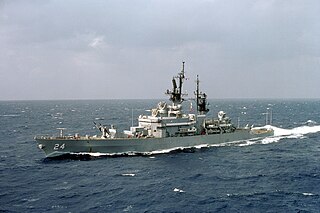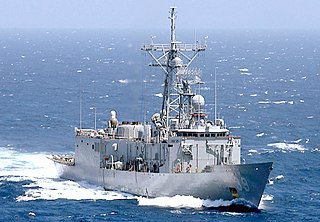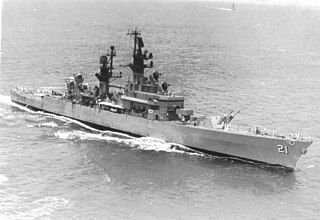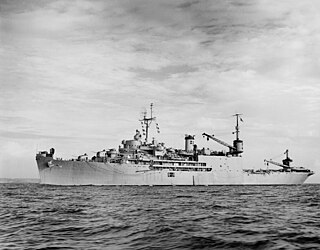
The fifth USS Truxtun (DLGN-35/CGN-35) was a nuclear powered cruiser in the U.S. Navy. She was launched as a destroyer leader and later reclassified as a cruiser. She was named after Commodore Thomas Truxtun (1755–1822). She was in service from May 1967 to September 1995.

USS Reeves (DLG/CG-24), a United States Navy ship named after Admiral Joseph Mason Reeves, was a Leahy-class cruiser built by the Puget Sound Naval Shipyard, in Bremerton, Washington.

USS Doyle (FFG-39) was the 30th ship to be constructed in the Oliver Hazard Perry class of guided missile frigates of the United States Navy. Doyle was named after Vice Admiral James Henry Doyle (1897–1982). Vice Admiral Doyle was most known for his contributions during the Korean War as Commander Amphibious Group One. The ship was in service from 21 May 1983 to 29 July 2011. During her 28 years of service, Doyle went on at least six deployments to the Mediterranean Sea and two deployments to the Persian Gulf, including participation in Operation Earnest Will. The ship also operated in the Black Sea, Baltic Sea, and deployed to operate with the Middle East Force. Doyle took part in UNITAS 39-98. Deployed to the Standing Naval Forces Atlantic, and conducted three Southern Command Deployments.

USS Dale (DLG-19/CG-19) was a Leahy-class cruiser in service with the United States Navy from 1963 to 1994. She was sunk as a target in 2000 off the East Coast of the United States near Maryland.

USS Gridley (DLG-21/CG-21), a Leahy-class guided missile cruiser, was the third ship of the United States Navy to be named after Charles Vernon Gridley, who distinguished himself with Admiral George Dewey's force at the Battle of Manila Bay on 1 May 1898.

USS Bainbridge (DLGN-25/CGN-25) was a nuclear-powered guided missile cruiser in the United States Navy, the only ship of her class. Named in honor of Commodore William Bainbridge, she was the fourth US Navy ship to bear the name. With her original hull classification symbol of DLGN, she was the first nuclear-powered destroyer-type ship in the US Navy, and shared her name with the lead ship of the first US Navy destroyer class, the Bainbridge-class destroyers.

USS Paul F. Foster (DD-964), named for Vice Admiral Paul F. Foster USN (1889–1972), is a Spruance-class destroyer built by the Ingalls Shipbuilding Division of Litton Industries at Pascagoula, Mississippi. She was commissioned on 21 February 1976 and decommissioned on 27 March 2003. She is now ex-Paul F. Foster, serving as a Self Defense Test Ship for experimental U.S. Navy weapons and sensors.

USS California (CGN-36), the lead ship of the California-class of nuclear-powered guided missile cruisers, was the sixth warship of the United States Navy to be named for the state of California. She was the last active nuclear-powered cruiser for the United States.

USS Shasta (AE-33) was a Kilauea-class replenishment ammunition ship of the United States Navy. She was named after Mount Shasta, a volcano in the Cascade Range in northern California. Shasta's mission was to support forward deployed aircraft carrier battle groups, which she accomplished through underway replenishment and vertical replenishment. Over three decades, Shasta and her crew took part in the Vietnam War, the Cold War, the Iran–Iraq War, Desert Shield/Operation Desert Storm, and numerous other actions.

USS Fox (DLG-33/CG-33) was a Belknap class cruiser of the United States Navy, named after Gustavus V. Fox, President Abraham Lincoln's Assistant Secretary of the Navy. The keel for DLG-33 was authenticated and laid in ceremonies at Todd Shipyards, Los Angeles Division, San Pedro, California on 15 January 1963.

USS Pine Island (AV-12), a Currituck-class seaplane tender, is the only ship of the United States Navy to hold this name. The ship was named after Pine Island Sound.

The Phutthayotfa Chulalok-class frigates are two of forty-six Knox-class frigates originally laid down for the United States Navy as ocean escorts, but were all redesignated as frigates on 30 June 1975, in the USN 1975 ship reclassification and their hull designation changed from DE to FF. The Thai Navy acquired them between 1994 and 1996.

USS Richmond K. Turner was a Leahy-class cruiser destroyer leader in the United States Navy. The ship was named for Admiral Richmond K. Turner, who served during World War II.

USS Sterett (DLG/CG-31) was a Belknap-class destroyer leader / cruiser. She was the third ship to be named for Master Commandant Andrew Sterett (1778–1807), who served during the Quasi-War with France and the Barbary Wars. She was launched as DLG-31, a frigate, and reclassified a cruiser (CG) on 30 June 1975.

USS Meyerkord (FF-1058) was a Knox-class frigate in service with the United States Navy from 1969 to 1991. She was scrapped in 2001.

The fourth USS Worden (DLG/CG-18), a Leahy-class cruiser, was a ship of the United States Navy named in honor of Admiral John L. Worden. Originally called a "destroyer leader" or frigate, in 1975 she was redesignated a cruiser in the Navy's ship reclassification. The ship entered service in 1963 and participated in the Vietnam War.

USS Jason (AR-8) was the fourth of the Vulcan class repair ship of the United States Navy in service from 1944 to 1995, serving in World War II, Korea, Vietnam, and the Gulf War. At the time of her decommissioning, Jason was the oldest ship in continual commission in the United States Navy, and the final ship in continual commission from World War II onward.
USS Deliver (ARS-23) was a Diver-class rescue and salvage ship commissioned by the U.S. Navy during World War II. Her task was to come to the aid of stricken vessels.

USS Safeguard (ARS-25) was a Diver-class rescue and salvage ship in service with the United States Navy from 1944 to 1947 and from 1952 to 1979. She was then transferred to Turkey where she served as TCG Işın (A-589) until 2017.




















